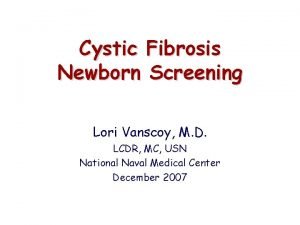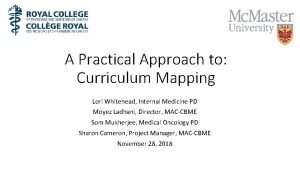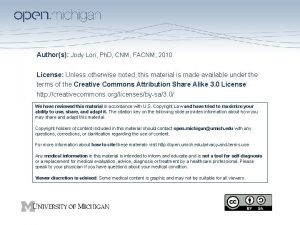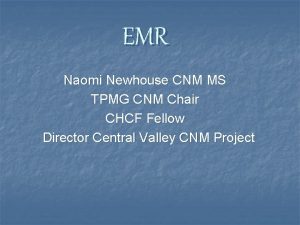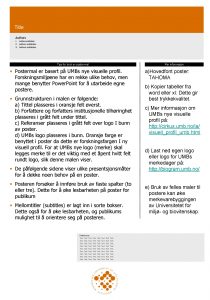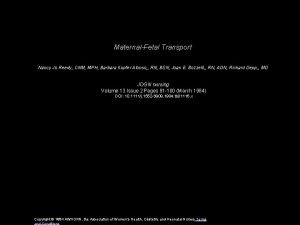Authors Jody Lori Ph D CNM FACNM 2010




































- Slides: 36

Author(s): Jody Lori, Ph. D, CNM, FACNM, 2010 License: Unless otherwise noted, this material is made available under the terms of the Creative Commons Attribution Share Alike 3. 0 License: http: //creativecommons. org/licenses/by-sa/3. 0/ We have reviewed this material in accordance with U. S. Copyright Law and have tried to maximize your ability to use, share, and adapt it. The citation key on the following slide provides information about how you may share and adapt this material. Copyright holders of content included in this material should contact open. michigan@umich. edu with any questions, corrections, or clarification regarding the use of content. For more information about how to cite these materials visit http: //open. umich. edu/privacy-and-terms-use. Any medical information in this material is intended to inform and educate and is not a tool for self-diagnosis or a replacement for medical evaluation, advice, diagnosis or treatment by a healthcare professional. Please speak to your physician if you have questions about your medical condition. Viewer discretion is advised: Some medical content is graphic and may not be suitable for all viewers.

Citation Key for more information see: http: //open. umich. edu/wiki/Citation. Policy Use + Share + Adapt { Content the copyright holder, author, or law permits you to use, share and adapt. } Public Domain – Government: Works that are produced by the U. S. Government. (17 USC § 105) Public Domain – Expired: Works that are no longer protected due to an expired copyright term. Public Domain – Self Dedicated: Works that a copyright holder has dedicated to the public domain. Creative Commons – Zero Waiver Creative Commons – Attribution License Creative Commons – Attribution Share Alike License Creative Commons – Attribution Noncommercial Share Alike License GNU – Free Documentation License Make Your Own Assessment { Content Open. Michigan believes can be used, shared, and adapted because it is ineligible for copyright. } Public Domain – Ineligible: Works that are ineligible for copyright protection in the U. S. (17 USC § 102(b)) *laws in your jurisdiction may differ { Content Open. Michigan has used under a Fair Use determination. } Fair Use: Use of works that is determined to be Fair consistent with the U. S. Copyright Act. (17 USC § 107) *laws in your jurisdiction may differ Our determination DOES NOT mean that all uses of this 3 rd-party content are Fair Uses and we DO NOT guarantee that your use of the content is Fair. To use this content you should do your own independent analysis to determine whether or not your use will be Fair.

Perspectives in Global Health Human Rights and the Determinants of Health Jody Lori CNM, Ph. D, FACNM

Objectives • Discuss global health and why should we study it • Discuss the meaning of a “human rights” approach to health • Review select ethical and human rights concerns • Review ethical guidelines for research with human subjects • Describe determinants of health and key health indicators

What is Global Health?

Global Health “An area for study, research, and practice that places a priority on improving health and achieving equity in health for all people worldwide…emphasizes transnational health issues, determinants and solutions: involves many disciplines within and beyond the health sciences and promotes interdisciplinary collaboration; and is a synthesis of populationbased prevention with individual-level care. ” (Kaplan et al. Towards a common definition of global health, The Lancet, vol. 373, June 6, 2009) Mike Blyth, Wikimedia Commons

Why Study Global Health?

Why Study Global Health • There has been important progress in life expectancy … yet …. • 10, 000 babies die every day in the world before they are four weeks old • 529, 000 women a year die in childbirth • More than 750, 000 children die every year of measles • 1. 6 million people die in the world every year of TB

Additional Reasons to Study Global Health - Disparities INDICATORS LIBERIA UNITED STAES (2007) (2005 -2007) Population 3. 2 million 300 million Life Expectancy for Females at Birth 44 years 81 years 37 years 71 years Total Expenditure on Health per capita $22. $6697. Maternal Mortality Rate (per 100, 000 live births) 994 14 Under 5 Mortality Rate (per 1, 000 live births) 110 8 Infant Mortality Rate (per 1, 000 live births) 71 7 Fertility Rate per Woman 5. 2 <2. 0 Coverage of Vital Registration of Deaths <25% 100% Healthy Life Expectancy at Birth for Females Source: Undetermined

Additional Reasons to Study Global Health • Link between health and development • Nature of many global health concerns • Need for different actors to work together • To learn about low-cost but highly effective interventions

Critical Global Health Concepts • The determinants of health • The importance of culture to health • The global burden of disease • Risk factors

Additional Concepts of Importance • The demographic and epidemiological transitions • The organization and functions of health systems • Links between health and education, and health, equity, poverty, and development

Key Terms • Developed and developing countries • Classification of low-income, middle-income, and high-income countries • World Bank regions • The Millennium Development Goals

World Bank Regions Source: World Bank

WHO Regions Source: WHO

Human Rights

Human Rights Framework • Cut across many areas of both human endeavor and government responsibility • Strong complementarily between good ethical and human rights practices and good health outcomes

Foundations for Health and Human Rights • Universal Declaration of Human Rights (UDHR), 1948 • 20 multilateral treaties related to health that are legally binding on the countries that sign them

Failure of Human Rights Iranian Woman Said to Be Lashed Over Photo LONDON — A mix-up over a photograph led to a sentence of 99 lashes for the Iranian woman whose earlier death sentence by stoning from Iranian authorities caused an international outcry, a lawyer for the woman said Sunday. By RAVI SOMAIYA Published: September 6, 2010 http: //www. nytimes. com/2010/09/06/world/middleeast/06 iran. html Sakineh #5, thiagolethi, flickr

Failure of Human Rights HUMAN RIGHTS WATCH A man with machete wounds to his head after being attacked by LRA rebels near Ngilima, northern Congo. February 21, 2009. © 2009 Reuters Please see original image of a man with machete wounds at http: //www. hrw. org/en/news/2010/03/28/dr-congo-lord-s-resistancearmy-rampage-kills-321

Research on Human Rights Abuses • Maternal mortality & women’s human rights in Afghanistan was assessed • 4, 886 Afghan women who provided maternal mortality data on 14, 085 sisters using the Sisterhood Method – 276 maternal deaths – 92% from rural areas – 87% women reported they had to obtain permission from their husband or male relative to seek health care – 12% used birth control, 23% desired to use birth control – Reported problems with access to adequate food, shelter & clean water Amowitz, Reis & Iacopino (2002), Maternal mortality in Herat province, Afghanistan, in 2002: an indicator of women’s human rights. JAMA, 288(10), 1284 -1291.

Research on Human Rights Abuses • Assess the nature and scope of human rights abuses with a focus on women’s rights in Iraq • Interviewed 1991 men and women from 3 major cities – supported a full range of human rights for women – Over 50% reported there were reasons to restrict educational and work opportunities for women – Freedom of movement for women – A man has the right to beat his wife if she disobeys him Amowitz, Kim, Reis, Asher & Iacopino (2004) , Human rights abuses and concerns about women’s health and human rights in southern Iraq. JAMA, 291(12), 1471 -1479.

What is a Human Rights Approach? “The enjoyment of the highest attainable standard of health is one of the fundamental rights of every human being. ” Preamble to the Constitution of the World Health Organization (WHO)

Rights Based Approach · Assess the impact of health policies, programs, and practices on human rights · Take account of the health impacts resulting from violations of human rights · See health and human rights as inextricably linked when considering the determinants of health and ways in which health issues may be addressed

Foundations for Research on Human Subjects • The Nuremberg Code, 1948 • The Declaration of Helsinki, 1964 • The Belmont Report, 1974

Determinants of Health & Key Health Indicators



What region of the world has the highest maternal mortality?

What region of the world has the highest infant mortality?

Countries with the highest rates of infant mortality • • • Sierra Leone 270 deaths per 1, 000 live births Angola 260 Afghanistan 257 Niger 253 Liberia 235 • United States 6. 7 • 13. 60 per 1, 000 live births for non-Hispanic black women vs. 5. 66 per 1, 000 live births for non. Hispanic white women

What are the 3 leading causes of death of children in the developing world? • • Pneumonia Accidents Measles HIV/AIDS Diarrhea War Cancer • • Suicide Malaria Tuberculosis Malnutrition Infectious diseases Polio Smallpox

What are the 3 leading causes of death of children in the developing world? • • Pneumonia Accidents Measles HIV/AIDS Diarrhea War Cancer • • Suicide Malaria Tuberculosis Malnutrition Infectious diseases Polio Smallpox

Take Home Messages • There are enormous disparities in health • There a variety of health determinants including genetic make-up, sex, social status, income, education, knowledge of health behaviors • Cooperation is needed to solve some global health problems • Need for more exposure to and training on ethical and human rights issues • A number of factors influence an individual’s health status

The health of each of us is linked to the health of all of us

Additional Source Information for more information see: http: //open. umich. edu/wiki/Citation. Policy Slide 6, Image 2: Mark Blyth, “A doctor scrubs in for surgery at ECWA Evangel Hospital, Jos, Nigeria”, Wikimedia Commons, http: //commons. wikimedia. org/wiki/File: Scrubbing_in. jpg , CC: BY-SA 3. 0, http: //creativecommons. org/licenses/by-sa/3. 0/. Slide 19, Image 1: thiagolethi, “Sakineh #5”, flickr, http: //www. flickr. com/photos/thiagolethi/5346518405/in/photostream/, CC: BY-NC-SA 2. 0, http: //creativecommons. org/licenses/by-nc-sa/2. 0/. Slide 20, Image 1: Please see original image of a man with machete wounds at http: //www. hrw. org/en/news/2010/03/28/dr-congo-lord-s-resistance -army-rampage-kills-321
 Jody lori
Jody lori Cnm 190
Cnm 190 Dallas midwife associates
Dallas midwife associates Cnm lineman program
Cnm lineman program Lori leiter
Lori leiter Duke pa program tuition
Duke pa program tuition Danielle lori doci
Danielle lori doci Lori pollock
Lori pollock Lori k grimes hill afb
Lori k grimes hill afb Lori vargo
Lori vargo Maximo everyplace
Maximo everyplace Lori stromness
Lori stromness Tatiana and krista hogan
Tatiana and krista hogan Lori fresina
Lori fresina Lori marsh
Lori marsh Lori cabrera
Lori cabrera Lori lynass
Lori lynass Fsu nicu mt
Fsu nicu mt Lori raetzman
Lori raetzman Organigramme alstom le creusot
Organigramme alstom le creusot Lori bounded
Lori bounded Met life
Met life Tim roth and lori baker
Tim roth and lori baker Lori blevins
Lori blevins Lori vanscoy
Lori vanscoy Lori whitehead
Lori whitehead Lori gillespie
Lori gillespie Lori simon-rusinowitz
Lori simon-rusinowitz Lori gillen sba
Lori gillen sba Lori hanson dnr
Lori hanson dnr Lori torres indiana
Lori torres indiana Ladislo biro
Ladislo biro Lori kempe
Lori kempe Lori carl
Lori carl Jody culham
Jody culham Jody decker
Jody decker Jody w. zylke
Jody w. zylke
























